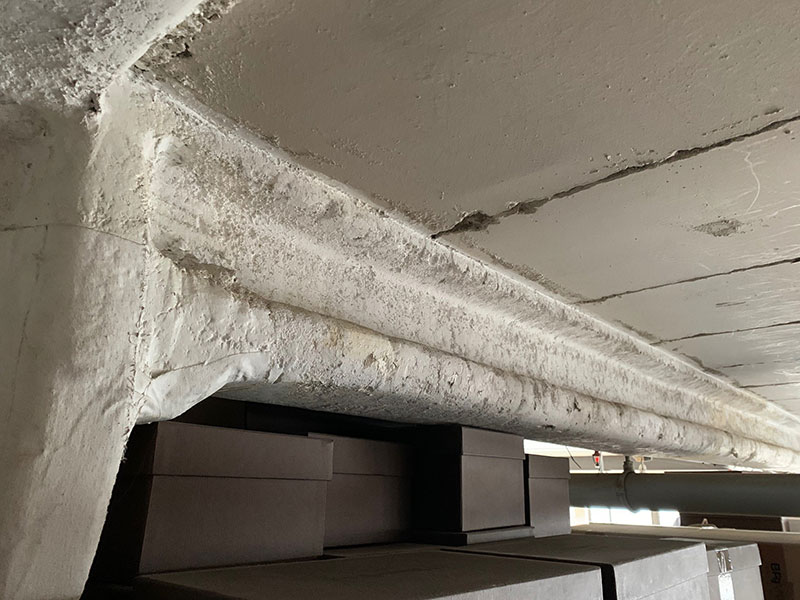What are the challenges and risks of removing asbestos spray coatings?
Before the health effects of asbestos were known, coatings that contained asbestos were sprayed onto various construction materials for different reinforcement purposes. To make a spray coating, asbestos fibres were added to adhesives and resins. The coating was then used for insulation, fireproofing, and soundproofing.
Asbestos spray coatings were phased out in the 1970s, and the UK banned all asbestos in 1999. However, any buildings that pre-date 2000 could still contain the material. Furthermore, since any asbestos spray coating existing today is more than 20 years old, it’s likely to be deteriorating. That means that it poses a high risk of asbestos exposure.
What makes the issue more critical is that asbestos spray coatings have an especially high asbestos content. Some coatings may contain as much as 85% pure asbestos.
In this article, we’ll discuss removal issues and best practices related to asbestos spray coatings. We’ll also explain why this type of asbestos-containing material (ACM) was once used.
Why were asbestos spray coatings used?
The primary use of asbestos spray coating in construction was fire protection and soundproofing on beams and ceilings, particularly in factories and warehouses. It was also used on the top of car parks, specifically those underneath apartments and hotels.
The process of applying asbestos spray coatings was a messy and dangerous one. Unfortunately, workers and the public didn’t yet know how harmful asbestos could be.
Without wearing the proper protective equipment, workers would use a large sprayer to apply the asbestos coating. Since the application wasn’t precise, the coating would often hit other items it wasn’t intended for. It ended up on nearby floors, walls, and windows, as well as in structural cavities.
What are the health risks of asbestos spray coatings?
One of the worst ACMs you could come across is an asbestos spray coating. Because it’s soft and low density, if disturbed even slightly, it can easily release dangerous asbestos fibres into the air.
When asbestos fibres become airborne, they can be inhaled or swallowed and then attach to a person’s lungs. Once there, they’re extremely difficult to detect and remove. Over time, asbestos exposure can cause life-threatening cancers and other diseases.
Asbestos spray coatings are among the most difficult types of ACMs to remove. They get into and onto practically everything in the area of application. Their high friability makes it easy to damage spray coatings during removal. And because of having such a high asbestos percentage, they’re extremely dangerous to inhale if an exposure event occurs.
How do you identify asbestos spray coating?
Luckily, asbestos spray coatings are typically easy to spot, so you’ll know which areas to avoid and when you need to hire a professional asbestos removal company.
Knowing where to look is a good first step. Most of the time, asbestos spray coatings can be found on beams and ceilings — anywhere where acoustic insulation, fireproofing, and thermal insulation would have been needed. It’s a common ACM found in car parks, factories, theatres, studios, and warehouses.
There are a few visual characteristics that indicate that a spray coating includes asbestos. Most notably, there’s usually so much asbestos in spray-coating ACMs that you can actually see the fibres. Asbestos spray coating is also gray-white in color and is very lumpy.
If the spray coating is fraying or falling off in clumps, it’s at its most dangerous. Chances are that there are already microscopic asbestos fibres in the air. Avoid walking in the area or disturbing the ACM further, and close off the area right away.
If you’re unsure whether or not spray coating contains asbestos, you can have it assessed and tested for confirmation. While it’s possible to send in a sample yourself for testing, it’s safest to avoid the area and have a professional conduct an asbestos survey and testing.
What should I know about removing asbestos spray coatings?
Only a licensed asbestos contractor can remove asbestos spray coatings because it’s such a high-risk process. They’ll have the necessary experience and licence for the job, and they’ll also have the specialised equipment to carry it out.
Not only are asbestos spray coatings friable and contain high amounts of asbestos, but the texture of the surface makes a difference, too. A smooth surface is easier to work with than a textured one. A surface with gaps, like you’ll find with pitted concrete, will have asbestos spray coating in the gaps, making the removal process much more difficult.
Having a licence for this type of work isn’t a suggestion or best practice — it’s a legal requirement according to the Health and Safety Executive. Removing asbestos spray coating falls under the category of high-intensity asbestos work, which requires a licence.
At times, encapsulation is an alternative to asbestos removal. With encapsulation, the ACM is treated so that fibres can’t escape. If removal is too risky at the moment or the removal process can’t begin right away, encapsulation may be used as a temporary solution.
How are asbestos spray coatings removed?
Before removal can begin, the removal contractor or team will examine the area and the surfaces that contain the coating. The entire work area will be enclosed before removal begins.
To remove asbestos spray coatings, what’s called an “injection suppression method” is used. During this process, an injection needle completely saturates the spray coating.
It’s important to keep all of the coating wet throughout. If even a small segment of the coating remains dry, fibres could be released. It’s also important to not saturate the coating too much because it can be difficult to remove if it becomes sludgy.
What safety measures are used during asbestos removal?
Asbestos workers use personal protective equipment (PPE) and respiratory protective equipment (RPE) to stay safe while working with asbestos and to prevent the spread of fibres once the workday is over. PPE includes:
- Disposable overalls, possibly waterproof depending on the type of work
- Single-use, disposable gloves
- Boots without laces; disposable overshoes aren’t worn because they can lead to slipping
- RPE, such as disposable respirators
Air monitoring and fibre removal take place during and after the removal process. Asbestos workers have to stay protected from exposure even while removal work is taking place. Afterward, anyone in the area needs to be safe from airborne fibres. In both cases, the air is tested to ensure it’s free of contamination.
In the event that exposure does occur during the removal process, it’s essential that the exposed party seeks medical attention. Regular health checkups may be required to mitigate any long-term effects the asbestos exposure might have.
How is asbestos waste disposed of?
The legal requirements for disposing of asbestos waste vary depending on where you are in the UK. In general, though, waste is considered contaminated if it has more than 0.1% asbestos. That means that specific regulations have to be followed when disposing of it. Typically, those include:
- Double-bagging all asbestos waste
- Properly labelling the bag to show it contains asbestos waste
- Not mixing asbestos waste with other types of waste
In addition to getting the waste ready for disposal, it also has to be transported in a way that it won’t be damaged. Lockable asbestos skips can be used for safe transport to a licensed disposal site. Note that anyone working with asbestos waste, including the skip driver, will need to wear PPE and RPE.
There are a few different types of landfills in the UK. The one you use for disposing of asbestos waste must be able to handle the type of ACMs you’re getting rid of. This is the only way to prevent contamination of air, soil, and water.
Do I need professional asbestos removal services?
Yes, you should always hire an asbestos professional for any asbestos-related job. Asbestos contractors and teams have the accreditation and licensing required for all sorts of asbestos-related jobs, from surveying and testing to removing and disposing of asbestos waste.
Even if you have a low-risk asbestos project that doesn’t require a licence, it’s still smart to use removal services instead of taking a DIY approach. Asbestos experts have the knowledge, experience, tools, and resources for performing safe removal from start to finish.
If you were to handle asbestos removal on your own, you could end up putting your own health or the health of others at risk without even knowing it. Furthermore, if you’re responsible for a commercial property, improper asbestos management could result in high fines or a prison sentence.
What are the next steps for asbestos removal?
Removing asbestos spray coatings is an incredibly delicate process. One small error or accident could result in high amounts of asbestos being inhaled, which can lead to life-threatening, difficult-to-treat diseases in the future.
It’s always the best option to hire a professional asbestos management and removal company. This is the only way to stay compliant with safety regulations while ensuring the health of anyone in the area.
To discuss your asbestos removal needs, contact Oracle Solutions today to speak with an expert.

Written by Callum McDonald
Callum McDonald is an expert in asbestos quality management, ensuring rigorous adherence to regulations and high-quality standards in removal projects. His focus on enhancing quality and client satisfaction makes him a crucial asset in safety and compliance within the field. Callum's expertise in technical support and oversight of licensed works underscores his commitment to excellence in asbestos management, providing invaluable guidance to clients in this specialised area.

